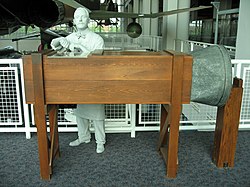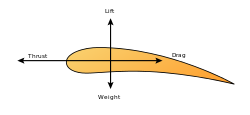Aerodynamics
Aerodynamics means studying how air (or gas) travels around something moving through it. Streamlining to reduce drag in vehicles is a major field in aerodynamics. Aircraft design is another.[1]
The study of gases that are not in motion is called aerostatics.
Aerodynamics comes from Aero (Air), and Dynamics (Moving).
For aircraft, lift (force) is the force pushing up. Gravity is the force pushing down. If lift is stronger than gravity the plane goes up. If gravity is stronger than lift, the plane goes down. In planes, lift is caused by airflow. Airplane wings are designed in such a way that, the air molecules prefer moving under the wing rather than above it, so as a result there is more air flowing underneath the wing compared to above it. This motion of the air gives upward lift to the aircraft. See Bernoulli's principle.
Thrust and drag govern forward motion. Thrust is the force pushing forward, and drag is the force pushing backward. Thrust is usually made by either propellers or jets. Drag is the force pushing backward. Most drag is caused by air friction.
Aerodynamics Media
A NASA wake turbulence study at Wallops Island in 1990. A vortex is created by passage of an aircraft wing, revealed by smoke. Vortices are one of the many phenomena associated with the study of aerodynamics.
A replica of the Wright brothers' wind tunnel is on display at the Virginia Air and Space Center. Wind tunnels were key in the development and validation of the laws of aerodynamics.
A Ministry of Aircraft Production poster on aerodynamics
Different types flow analysis around an airfoil: * Potential flow theory* Boundary layer flow theory* Turbulent wake analysis
References
- ↑ A Dictionary of Aviation, David W. Wragg. ISBN 9780850451634, 1st Edition Published by Osprey, 1973 / Published by Frederick Fell, Inc., NY, 1974 (1st American Edition.)




